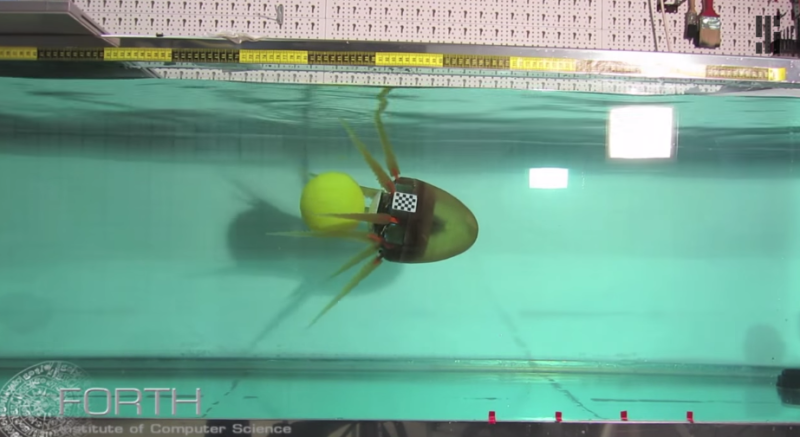Much of robotics has been advanced by recreating animals movements – Why reinvent the wheel when nature got it right first? But have you seen many aquatic creatures movements re-imagined with mechanical linkages? The Foundation for Research and Technology-Hellas (FORTH) has recently presented their robotic octopus at the International Conference on Intelligent Robots and Systems.
The eight armed (or is it legged?) roboctopus was based on of a real octopus which have a really cool method of propulsion which allows them to move at speeds of up to 40km/h. The researchers in Greece created slim silicon arms to recreate this movement, allowing their robot to propel itself at speeds of around 10cm/s — after adding webs to the arms, they were able to almost double its top speed to 18cm/s, or one-half its body length per second.
The cool thing about the bot is that other marine wild-life seem relatively unperturbed by it, which could open up many possibilities in underwater research!
Between robotic kangaroos, rats, red snappers and even elephants we’ll be able to have a robotic zoo in no time!
[via TechPlus24]

















After a bit of unit conversion, it does 0.7 kph, which is rubbish compared to 40 kph.
But amazing for a robotic imitation that can’t *quite* imitate the original properly. Tentacles are a LITTLE bit hard to imitate in robots, what with the infinite degree of flexibility and all.
Yes, this will definitely take over the seas.
I, for one, welcome our new overlords…
Greeks invented a robotic octopus? Did they eat it when they were done? Anyway it looks like it swims more like a jellyfish, why not forget the tentacles and just go for a full “cowl” or whatever the hell you call a jellyfish head.
Bell*
As a biologist, i couldn’t disagree more: Jellyfish swim with contractions of the bell (as Royell very correctly remarked) or as others call it: hood. Cephalopods on the other side, display a much wider range of motion modes. The ones displayed here, are motions performed mainly by the tentacles (an organ homologous to the foot of a gastropod (snail). Other modes of motion involve the contraction of the mantle which might initially look like the motion of the jellyfish but is in fact a more involved and much faster mode of motion.
Being a swimmer and looking at the motion in the footage provided I wonder why they didn’t incorporate a one-way water inlet valve. In strokes life the a portion of your forward motion is taken up by the recoil phase of the stroke, the same goes for the way the footage in this video shows its swim pattern. A simple oneway valve would reduce the drag caused by turbulance and resistance of the water refilling the expanding webbing of the tenticles. I would not be suprised if they could double their current speed and reduce energy consumption by including inlet valves.
Festo has jellyfish like this they bring to trade shows – the tentacles aren’t independent but it’s a charming display.
http://scienceblogs.com/zooillogix/2008/04/24/robotic-jellyfish-that-move-au/
Ok yeah I’m definitely getting a creepy vide from this.
vibe*
So remind me, what eats squid? Blue sharks eat squit https://www.youtube.com/watch?v=OlgsvnvcbC8